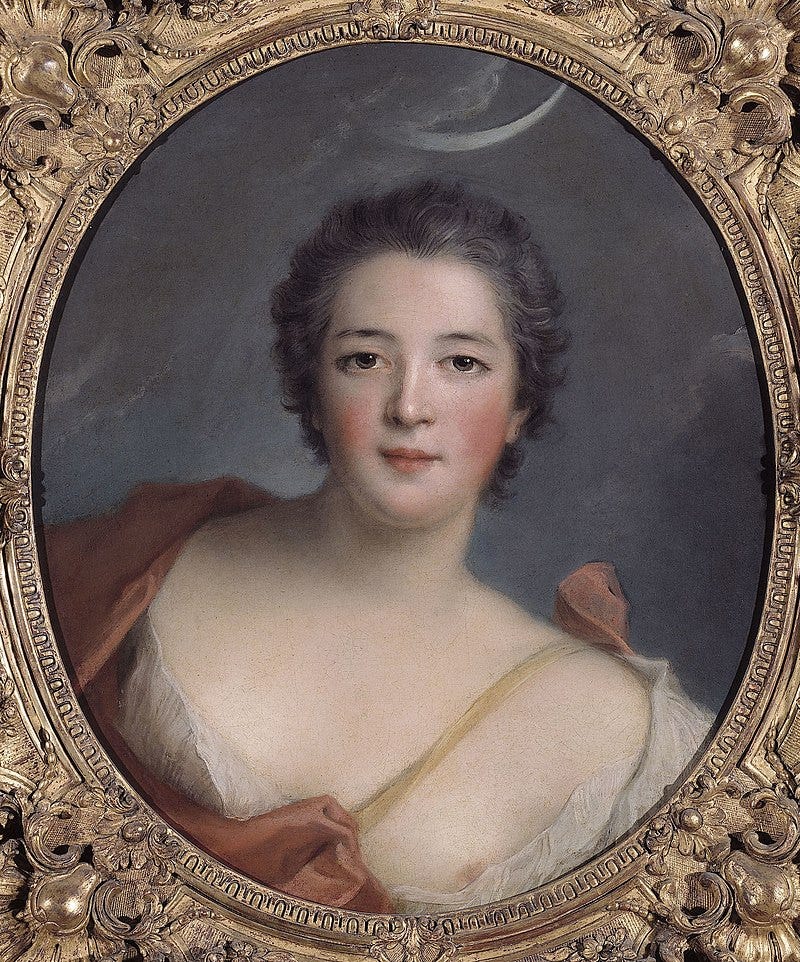On this day, Queen Marie has an interaction with one of the sisters of her husband’s mistress. Writing on 8 July, our diarist says:
“Mme de Flavacourt, who had been in Paris for a long time on account of her sister, Mme de La Tournelle, came yesterday to the Queen’s. It was in the afternoon, before the Queen was at her jeu (see glossary). There were only 2 dames du palais, Mme de Fleury and Mme de Rupelmonde, and Mme de Mazarin. The Queen asked Mme de Flavacourt if she had any knots, and Mme de Fleury lent her some of hers so that she could be seated. It is the usage, in the hour that only the entrées see the Queen (which is to say from five to six o’clock), that the Queen allows unqualified ladies to be seated if they are working.”
Commentary:
For etiquette fanciers, there is much to be unpacked here, but first it’s necessary to know several facts:
The King and Queen have not shared a bed since the birth of their last child in 1737, a daughter whom the King himself designated “Madame Dernière” when asked if she would ever have a younger sibling. The Queen closed her bedchamber door to her husband in the wake of her youngest’s birth because she needed a break, having endured 10 pregnancies in as many years. She probably did not mean for him to stay away for good, but that is what has happened.
In 1738, the King’s liaison with one of the Queen’s dames du palais, Mme de Mailly, became public knowledge. They had already been carrying on for several years in secret. Mme de Mailly thus became the first maîtresse-en-titre in more than 50 years, the first since Louis XIV dropped Mme de Montespan.
Mme de Mailly, the eldest of 5 girls, brought her next younger sister, Mme de Vintimille, into the King’s circle, thinking that her sibling would be a help to her. Instead, Mme de Vintimille supplanted her in the King’s bed in 1739.
All of the Mailly sisters — apart from Mmes de Mailly and de Vintimille, there are also, in order of age, Mmes de Lauraguais, de Flavacourt, and de La Tournelle — have benefitted materially and socially from the King’s interest in their family, and they are keen to exploit it to the full.
Pictured: Hortense-Félicité de Mailly-Nesle (1715-1799), Marquise de Flavacourt by marriage. In the long run, 2 things will distinguish her from her 4 sisters: she will never go to bed with the King and she will outlive them all. Credit — Par École de Jean-Marc Nattier — Paris Musées, Domaine public, https://commons.wikimedia.org/w/index.php?curid=92660244
Our diarist does not say why Mme de Flavacourt needed to be in Paris with Mme de La Tournelle. Perhaps the latter was ill.
Now to the niceties and interpretation of the etiquette that M de Luynes addresses. As he says, it is a time of day that only ladies who have the entrées (see glossary) may enter the Queen’s apartment. Mme de Flavacourt, newly in possession of the entrées thanks to her sisters’ success with the King, is trying her luck. She has got through the door, but there is another layer of privilege that she wishes to access. It is a quirk in the established etiquette that the Queen permits ladies present at this time of day to sit down only if they have work to do, which is to say needlework of some kind, as she herself does. It is otherwise not usually permitted to sit in the Queen’s presence unless one is a duchess, or a foreign princess, or a Grandee of Spain, etc. Mme de Flavacourt is none of those things. The Queen, normally gracious, is clearly not disposed to be gracious to a member of the maîtresse-en-titre’s family, for she issues a challenge to Mme de Flavacourt by asking if she has any work to do. Flavacourt is rescued, as we see, by Mme de Fleury. The latter has perhaps just taken pity on the visitor, or perhaps she is calculating that being nice to the favourite’s sister will her do her some good in future. Given that the Mailly sisters are going to make the Queen more and more miserable in the coming years, it is difficult to see this little scene as anything but a sign of things to come.
The translation from the French is my own. Images that are not my own are in the public domain; I only explicitly credit them when the uploader has made it a condition of sharing his/her work via Wikimedia Commons. Words in italics in the body of the post or bold italics in verbatim translations and image captions are in the Glossary; the royal family and other Bourbons are in the Who’s Who; information about the sources is in the Bibliography; all of these are in the Resources section and freely available to paid subscribers and Grandes Entrées. If you have questions, please ask in the comments.





This is so rich in content, it feels like the the outine of a novel (or series of them). Thank you for explaining the baffling etiquette so clearly. I was puzzled by the reference to "knots" intially.
10 pregnancies in as many years...the mind boggles, but this type of situation of course did not end with that era. There were 15 children in my maternal great-grandmother's family and 17 (!) in my paternal grandfather's.